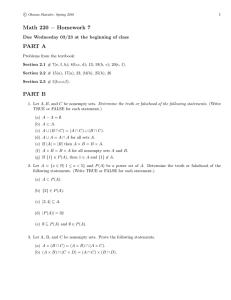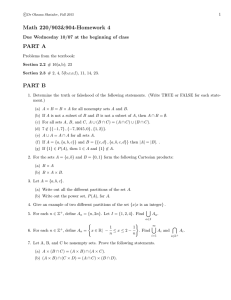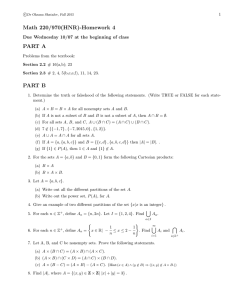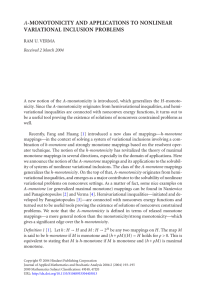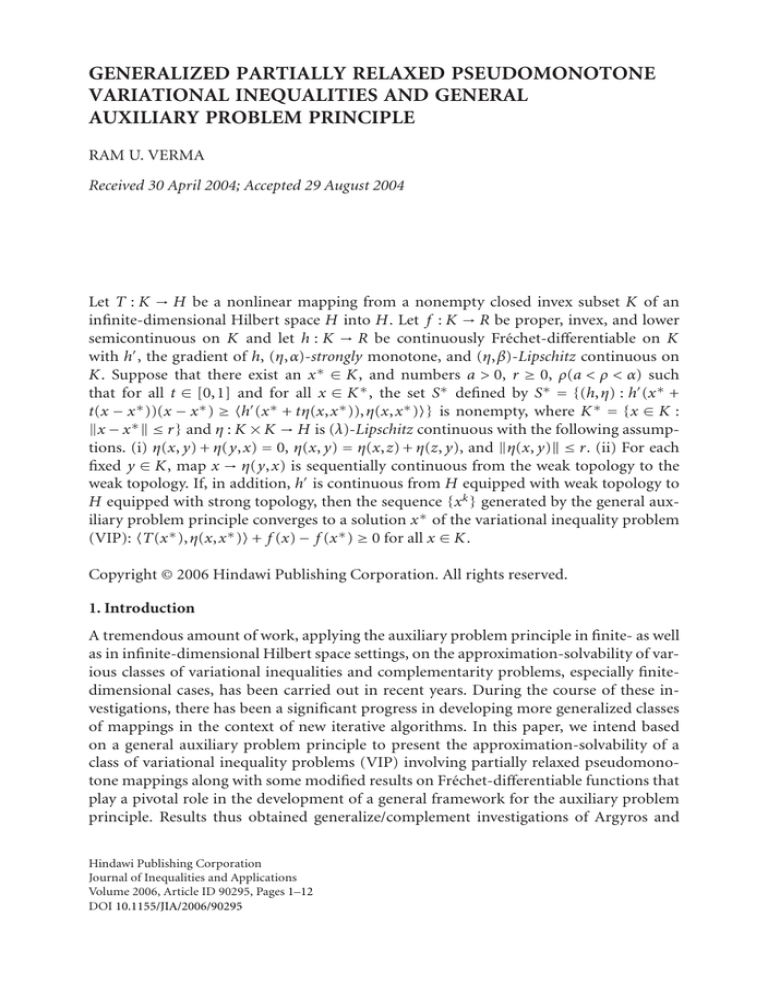
GENERALIZED PARTIALLY RELAXED PSEUDOMONOTONE
VARIATIONAL INEQUALITIES AND GENERAL
AUXILIARY PROBLEM PRINCIPLE
RAM U. VERMA
Received 30 April 2004; Accepted 29 August 2004
Let T : K → H be a nonlinear mapping from a nonempty closed invex subset K of an
infinite-dimensional Hilbert space H into H. Let f : K → R be proper, invex, and lower
semicontinuous on K and let h : K → R be continuously Fréchet-differentiable on K
with h , the gradient of h, (η,α)-strongly monotone, and (η,β)-Lipschitz continuous on
K. Suppose that there exist an x∗ ∈ K, and numbers a > 0, r ≥ 0, ρ(a < ρ < α) such
that for all t ∈ [0,1] and for all x ∈ K ∗ , the set S∗ defined by S∗ = {(h,η) : h (x∗ +
t(x − x∗ ))(x − x∗ ) ≥ h (x∗ + tη(x,x∗ )),η(x,x∗ )} is nonempty, where K ∗ = {x ∈ K :
x − x∗ ≤ r } and η : K × K → H is (λ)-Lipschitz continuous with the following assumptions. (i) η(x, y) + η(y,x) = 0, η(x, y) = η(x,z) + η(z, y), and η(x, y) ≤ r. (ii) For each
fixed y ∈ K, map x → η(y,x) is sequentially continuous from the weak topology to the
weak topology. If, in addition, h is continuous from H equipped with weak topology to
H equipped with strong topology, then the sequence {xk } generated by the general auxiliary problem principle converges to a solution x∗ of the variational inequality problem
(VIP): T(x∗ ),η(x,x∗ ) + f (x) − f (x∗ ) ≥ 0 for all x ∈ K.
Copyright © 2006 Hindawi Publishing Corporation. All rights reserved.
1. Introduction
A tremendous amount of work, applying the auxiliary problem principle in finite- as well
as in infinite-dimensional Hilbert space settings, on the approximation-solvability of various classes of variational inequalities and complementarity problems, especially finitedimensional cases, has been carried out in recent years. During the course of these investigations, there has been a significant progress in developing more generalized classes
of mappings in the context of new iterative algorithms. In this paper, we intend based
on a general auxiliary problem principle to present the approximation-solvability of a
class of variational inequality problems (VIP) involving partially relaxed pseudomonotone mappings along with some modified results on Fréchet-differentiable functions that
play a pivotal role in the development of a general framework for the auxiliary problem
principle. Results thus obtained generalize/complement investigations of Argyros and
Hindawi Publishing Corporation
Journal of Inequalities and Applications
Volume 2006, Article ID 90295, Pages 1–12
DOI 10.1155/JIA/2006/90295
2
Auxiliary problem principle
Verma [1], El Farouq [7], Verma [20], and others. For more details on general variational
inequality problems and the auxiliary problem principle, we refer to [1–23].
Let H be an infinite-dimensional real Hilbert space with the inner product x, y and
norm x for all x, y ∈ H. We consider the variational inequality problem (VIP) as follows: determine an element x∗ ∈ K such that
T x∗ ,η x,x∗
+ f (x) − f x∗ ≥ 0 ∀x ∈ K,
(1.1)
where K is a nonempty closed invex subset of H, and η : K × K → H is any mapping with
some additional conditions.
When η(x,x∗ ) = x − x∗ , the VIP (1.1) reduces to the VIP: determine an element x∗ ∈
K such that
T x∗ ,x − x∗ + f (x) − f x∗ ≥ 0
∀x ∈ K,
(1.2)
where K is a nonempty closed convex subset of H.
When f = 0 in (1.2), it reduces to the following: find an element x∗ ∈ K such that
T x∗ ,x − x∗ ≥ 0 ∀x ∈ K.
(1.3)
Now we recall the following auxiliary result for the approximation solvability of nonlinear variational inequality problems based on iterative procedures.
Lemma 1.1. For elements u,v,w ∈ H,
2
1
u2 + u,η(v,w) ≥ − η(v,w) .
4
(1.4)
Lemma 1.2. For u,v ∈ H,
u,v =
u + v 2 − u 2 − v 2
2
.
(1.5)
Now recall and in some cases upgrade the existing notions in the literature. Let η : H × H →
H be any mapping.
Definition 1.3. A mapping T : H → H is called
(i) (η)-monotone if for each x, y ∈ H, there exists,
T(x) − T(y),η(x, y) ≥ 0;
(1.6)
(ii) (η,r)-strongly monotone if there exists a positive constant r such that
T(x) − T(y),η(x, y) ≥ r x − y 2
∀x, y ∈ H;
(1.7)
(iii) (r)-expansive if
T(x) − T(y) ≥ r η(x, y);
(iv) expansive if r = 1 in (iii),
(1.8)
Ram U. Verma 3
(v) (η,γ)-cocoercive if there exists a constant γ > 0 such that
2
T(x) − T(y),η(x, y) ≥ r T(x) − T(y)
∀x, y ∈ H;
(1.9)
(vi) (η)-pseudomonotone if
T(y),η(x, y) ≥ 0 =⇒ T(x),η(x, y) ≥ 0;
(1.10)
(vii) (η,b)-strongly pseudomonotone if
T(y),η(x, y) ≥ 0 =⇒ T(x),η(x, y) ≥ bx − y 2
∀x, y ∈ H;
(1.11)
(viii) (η,c)-pseudococoercive if there exists a constant c > 0 such that
2
T(y),η(x, y) ≥ 0 =⇒ T(x),η(x, y) ≥ cT(x) − T(y)
∀x, y ∈ H;
(1.12)
(ix) (η)-quasimonotone if
T(y),η(x, y) > 0 =⇒ T(x),η(x, y) ≥ 0 ∀x, y ∈ H;
(1.13)
(x) (η,L)-relaxed (also called weakly monotone) if there is a positive constant L such
that
T(x) − T(y),η(x, y) ≥ (−L)x − y 2
∀x, y ∈ H;
(1.14)
(xi) (η)-hemicontinuous if for all x, y,w ∈ H, the function
t ∈ [0,1] −→ T y + tη(x, y) ,w
(1.15)
is continuous;
(xii) (η,β)-Lipschitz continuous if there exists a constant β ≥ 0 such that
T(x) − T(y) ≤ βη(x, y);
(1.16)
(xiii) (η,γ)-partially relaxed monotone if there exists a positive constant γ such that
T(x) − T(y),η(z, y) ≥ (−γ)z − x2
∀x, y,z ∈ H;
(1.17)
(xiv) (η,γ)-partially relaxed pseudomonotone if there exists a positive constant γ such
that
T(y),η(z, y) ≥ 0 =⇒ T(x),η(z, y) ≥ (−γ)z − x2
∀x, y,z ∈ H.
(1.18)
Lemma 1.4. Let T : H → H be (η,α)-cocoercive and let η : H × H → H be a mapping such
that
(i) η(x, y) ≤ λx − y ;
(ii) η(x, y) + η(y,x) = 0;
(iii) η(x, y) = η(x,z) + η(z, y).
Then T is (η, −(λ2 /4α))-partially relaxed monotone.
4
Auxiliary problem principle
Proof. Since T : H → H is (η,α)-cocoercive, we have
T(x) − T(y),η(z, y) = T(x) − T(y),η(z,x) + T(x) − T(y),η(x, y)
2 ≥ αT(x) − T(y) + T(x) − T(y),η(z,x)
2 1 T(x) − T(y),η(z,x)
= α T(x) − T(y) +
α
(1.19)
2
1
η(z,x)2 ≥ − λ z − x2 .
≥−
4α
4α
Definition 1.5. A mapping T : H → H is said to be μ-cocoercive [2] if for each x, y ∈ H,
there exists
2
T(x) − T(y),x − y ≥ μT(x) − T(y) ,
(1.20)
where μ is a positive constant.
Example 1.6. Let T : K → H be nonexpansive. Then I − T is 1/2-cocoercive, where I is the
identity mapping on H. For if x, y ∈ K, we have
(I − T)(x) − (I − T)(y)2 = x − y − T(x) − T(y) 2
2
= x − y 2 − 2 x − y,T(x) − T(y) + T(x) − T(y)
≤ 2 x − y 2 − x − y,T(x) − T(y)
= 2 x − y,(I − T)(x) − (I − T)(y) ,
(1.21)
that is,
2
1
(I − T)(x) − (I − T)(y),x − y ≥ (I − T)(x) − (I − T)(y) .
2
(1.22)
A subset K of H is said to be invex if there exists a function η : K × K → H such that
whenever x, y ∈ K and t ∈ [0,1], it follows that
x + tη(y,x) ∈ K.
(1.23)
A function f : K → R is called invex if whenever x, y ∈ K and t ∈ [0,1], it follows that
f x + tη(y,x) ≤ (1 − t) f (x) + t f (y).
(1.24)
2. Some auxiliary results
This section deals with some auxiliary results [2] and their modified versions crucial
to the approximation-solvability of VIP (1.1). Let h : H → R be a continuously Fréchetdifferentiable mapping on a Hilbert space H. It follows that h (x) ∈ L(H,R)—the space
of all bounded linear operators from H into R. From now on, we will denote the real
number h (x)(y) by h (x), y for all x, y ∈ H.
Ram U. Verma 5
Lemma 2.1. Let H be a real Hilbert space and let K be a nonempty closed invex subset of
H. Let h , the gradient of h : K → R, be (η,α)-strongly monotone on K and let the following
assumptions hold.
(i) There exist an x∗ ∈ K and a number r ≥ 0 such that for all x ∈ K ∗ and t ∈ [0,1], the
mapping η : K × K → H satisfies
η(x, y) ≤ r.
(2.1)
(ii) The set S∗ defined by
S∗ = (h,η) : h x∗ + t x − x∗
x − x∗ ≥ h x∗ + tη x,x∗ ,η x,x∗
(2.2)
is nonempty, where h : K → R is a continuously Fréchet-differentiable mapping, and the set
K ∗ is defined by
K ∗ = x ∈ K : x − x∗ ≤ r .
(2.3)
Then for all x ∈ K ∗ and (h,η) ∈ S∗ ,
h(x) − h x∗ − h x∗ ,η x,x∗
≥
α
x − x ∗ 2 .
2
(2.4)
Lemma 2.2. Let H be a real Hilbert space and let K be a nonempty closed convex subset of
H. Let h , the gradient of h : K → R, be (α)-strongly monotone on K and let h : K → R be a
continuously Fréchet-differentiable mapping. Then for all x,x∗ ∈ K,
2
α
h(x) − h x∗ − h x∗ ,x − x∗ ≥ x − x∗ .
2
(2.5)
Lemma 2.3. Let H be a real Hilbert space and let K be a nonempty closed invex subset of H.
Let h , the gradient of h : K → R, be (η,δ)-Lipschitz continuous on K and let the following
assumptions hold.
(i) There exist an x∗ ∈ K and a number q ≥ 0 such that for all x ∈ K1 and t ∈ [0,1], the
mapping η : K × K → H satisfies
η(x, y) ≤ q.
(2.6)
(ii) The set S1 defined by
S1 = (h,η) : h x∗ + t x − x∗
x − x∗ ≤ h x∗ + tη x,x∗ ,η x,x∗
(2.7)
is nonempty, where h : K → R is a continuously Fréchet-differentiable mapping, and the set
K1 is defined by
K1 = x ∈ K : x − x ∗ ≤ q .
(2.8)
Then for all x ∈ K1 and (h,η) ∈ S1 ,
h(x) − h x∗ − h x∗ ,η x,x∗
≤
δ
x − x ∗ 2 .
2
(2.9)
6
Auxiliary problem principle
3. General auxiliary problem principle
In this section, we present the approximation-solvability of the VIP (1.1) using the convergence analysis for the general auxiliary problem principle.
Algorithm 3.1. For arbitrarily chosen initial point x0 ∈ K, determine an iterate xk+1 such
that
ρT xk + h xk+1 − h xk ,η x,xk+1
+ ρ f (x) − f xk+1
≥ 0,
(3.1)
for all x ∈ K, where h : K → R is continuously Fréchet-differentiable, f : K → R is proper,
invex, and lower semicontinuous, ρ > 0, and η : K × K → H is any mapping.
Algorithm 3.2. For arbitrarily chosen initial point x0 ∈ K, determine an iterate xk+1 such
that
ρT xk + h xk+1 − h xk ,x − xk+1 + ρ f (x) − f xk+1
≥ 0,
(3.2)
for all x ∈ K, where h : K → R is continuously Fréchet-differentiable, ρ > 0, and K is a
nonempty closed convex subset of H.
Algorithm 3.3. For arbitrarily chosen initial point x0 ∈ K, determine an iterate xk+1 such
that
ρT xk + h xk+1 − h xk ,x − xk+1 ≥ 0,
(3.3)
for all x ∈ K, where h : K → R is continuously Fréchet-differentiable, ρ > 0, and K is a
nonempty closed convex subset of H.
We now present, based on Algorithm 3.1, the approximation solvability of the VIP
(1.1) in a Hilbert space setting.
Theorem 3.4. Let H be a real infinite-dimensional Hilbert space and let K be a nonempty
closed invex subset of H. Let T : K → H be (η,γ)-partially relaxed pseudomonotone. Let
f : K → R be proper, invex, and lower semicontinuous on K, let h : K → R be continuously
Fréchet-differentiable on K with h , the gradient of h, (η,α)-strongly monotone, and (η,β)Lipschitz continuous, and let h be continuous from H equipped with weak topology to H
equipped with strong topology. Suppose that the following assumptions hold.
(i) There exist a y ∗ ∈ K and numbers a > 0, r ≥ 0, ρ(a < ρ < α/2γ) such that for all
t ∈ [0,1] and for all x ∈ K ∗ , the set S∗ defined by
S∗ = (h,η) : h y ∗ + t x − y ∗
x − y ∗ ≥ h y ∗ + tη x, y ∗ ,η x, y ∗
(3.4)
is nonempty, where
K ∗ = x ∈ K : x − y ∗ ≤ r ⊂ K.
(ii) The mapping η : K × K → H is (λ)-Lipschitz continuous.
(iii) η(u,v) + η(v,u) = 0 and η(u,v) = η(u · w) + η(w,v).
(3.5)
Ram U. Verma 7
(iv) For each fixed y ∈ K, the map x → η(y,x) is sequentially continuous from the weak
topology to the weak topology.
(v) η(u,v) ≤ r.
Then an iterate xk+1 is a unique solution to (3.1).
If, in addition, x∗ ∈ K is a solution to VIP (1.1) and T(xk ) − T(x∗ ) → 0, then the
sequence {xk } generated by Algorithm 3.1 converges weakly to x∗ .
Proof. First to show that xk+1 is a unique solution to (3.1), assume that y k+1 is another
distinct solution to (3.1). Since h is (η,α)-strongly monotone, it follows applying (3.1)
that
− h xk+1 − h y k+1 ,η xk+1 , y k+1 ≥ 0,
(3.6)
k+1
x − y k+1 2 ≤ 0,
(3.7)
or
a contradiction.
Since x∗ ∈ K is a solution to the VIP (1.1), we define a function Δ∗ by
Δ∗ (x) := h x∗ − h(x) − h (x),η x∗ ,x .
(3.8)
Then applying Lemma 2.1, we have
Δ∗ (x) := h x∗ − h(x) − h (x),η x∗ ,x
≥
α
x ∗ − x 2 .
2
(3.9)
It follows that
Δ∗ xk+1 := h x∗ − h xk+1 − h xk+1 ,η x∗ ,xk+1 .
Now we can write
Δ∗ xk − Δ∗ xk+1 = h xk+1 − h xk − h xk ,η xk+1 ,xk
(3.10)
+ h xk+1 − h xk ,η x∗ ,xk+1
2 α
≥ xk+1 − xk + h xk+1 − h xk ,η x∗ ,xk+1
2
2
α
≥ xk+1 − xk + ρ T xk ,η xk+1 ,x∗
2
+ ρ f xk+1 − f x∗ ,
(3.11)
for x = x∗ in (3.1).
Therefore, we have
2
α
Δ∗ xk − Δ∗ xk+1 ≥ xk+1 − xk + ρ T xk ,η xk+1 ,x∗ + ρ f xk+1 − f x∗ .
2
(3.12)
If we replace x by xk+1 in (1.1), we obtain
T x∗ ,η xk+1 ,x∗
+ f xk+1 − f x∗ ≥ 0.
(3.13)
8
Auxiliary problem principle
Since T is (η,γ)-partially relaxed pseudomonotone, it implies in light of (3.13) that
2
2
2
α
α
Δ∗ xk − Δ∗ xk+1 ≥ xk+1 − xk − ργxk+1 − xk =
− ργ xk+1 − xk 2
2
(3.14)
for ρ < (α/2γ).
It follows that the sequence {Δ∗ (xk )} is a strictly decreasing sequence except for xk+1 =
k
x , and in that situation xk is a solution to (1.1). Since the difference of two consecutive
terms tends to zero as k → ∞, it implies that
k+1
x − xk −→ 0
as k −→ ∞.
(3.15)
On the top of that, in light of Lemma 2.1, we have
∗
x − xk 2 ≤ 2 Δ∗ xk ,
(3.16)
α
and so the sequence {xk } is bounded. Let x be a cluster point of the sequence {xk }, that
is, there exists a subsequence {xk j } of the sequence {xk } such that {xk j } converges weakly
to x . Since h is (η,β)-Lipschitz continuous and a < ρ, it follows using (3.1) that for some
x ∈ K, we have
ρT xk ,η x,xk+1
+ ρ f (x) − f xk+1
≥ − h xk+1 − h xk ,η x,xk+1
≥ −βxk+1 − xk η x,xk+1 ,
(3.17)
or
k T x ,η x,xk+1
β
+ f (x) − f xk+1 ≥ − xk+1 − xk η x,xk+1 .
a
(3.18)
Since T(xk j ) converges strongly to T(x∗ ) and xk j+1 − xk j → 0, and f is invex and lower
semicontinuous (and hence f is weakly lower semicontinuous), it follows from (3.18)
that
T x∗ ,η(x,x ) + f (x) − f (x ) ≥ 0 ∀x ∈ K,
(3.19)
while
T(x ),η xk j ,x
+ f (x) − f xk j −→ 0,
T(x ),η xk j ,x
−→ 0.
(3.20)
At this stage, if T(x ) = 0, then x is a solution to the VIP (1.1); and if T(x ) = 0, then we
express it in the form
η y k j ,xk j = −
T(x ),η xk j ,x T(x )
T(x )2
.
(3.21)
Ram U. Verma 9
It follows that
T(x ),η y k j ,x
= 0,
(3.22)
and thus, we have
k j k j η y ,x −→ 0.
(3.23)
y k j x .
(3.24)
It follows that
Applying (3.22), we have
0 = T(x ),η y k j ,x
= T(x ),η y k j ,x∗ + T(x ),η x∗ ,x .
(3.25)
Since T(x ) = 0, it follows that y k j x∗ and x∗ = x , a solution to the VIP (1.1).
Corollary 3.5. Let H be a real infinite-dimensional Hilbert space and let K be a nonempty
closed invex subset of H. Let T : K → H be (η,γ)-pseudococoercive. Let f : K → R be proper,
invex, and lower semicontinuous on K, let h : K → R be continuously Fréchet-differentiable
on K with h , the gradient of h, (η,α)-strongly monotone and (η,β)-Lipschitz continuous,
and let h be continuous from H equipped with weak topology to H equipped with strong
topology. Suppose that the following assumptions hold.
(i) There exist a y ∗ ∈ K and numbers a > 0, r ≥ 0, ρ(a < ρ < α/2γ) such that for all
t ∈ [0,1] and for all x ∈ K ∗ , the set S∗ defined by
S∗ = (h,η) : h y ∗ + t x − y ∗
x − y ∗ ≥ h y ∗ + tη x, y ∗ ,η x, y ∗
(3.26)
is nonempty, where
K ∗ = x ∈ K : x − y ∗ ≤ r ⊂ K.
(3.27)
(ii) The mapping η : K × K → H is (λ)-Lipschitz continuous.
(iii) η(u,v) + η(v,u) = 0 and η(u,v) = η(u · w) + η(w,v).
(iv) For each fixed y ∈ K, the map x → η(y,x) is sequentially continuous from the weak
topology to the weak topology.
(v) η(u,v) ≤ r.
Then an iterate xk+1 is a unique solution to (3.1).
If x∗ ∈ K is a solution to VIP (1.1), then the sequence {xk } generated by Algorithm 3.1
converges weakly to x∗ .
For f = 0 and η(u,v) = u − v in Corollary 3.5, it reduces to the following corollary.
Corollary 3.6. Let H be a real infinite-dimensional Hilbert space and let K be a nonempty
closed convex subset of H. Let T : K → H be (γ)-pseudococoercive. Let h : K → R be continuously Fréchet-differentiable on K with h , the gradient of h, (α)-strongly monotone, and
(β)-Lipschitz continuous, and let h be continuous from H equipped with weak topology to H
equipped with strong topology. Then an iterate xk+1 is a unique solution to (3.3). If x∗ ∈ K is
10
Auxiliary problem principle
a solution to VIP (1.3), then the sequence {xk } generated by Algorithm 3.3 converges weakly
to x∗ .
Note that Corollary 3.6 is proved in [7, Theorem 4.1] with an additional imposition of
the uniform continuity on the mapping T, but we feel that the uniform continuity is not
required for the convergence purposes.
Theorem 3.7. Let H be a real infinite-dimensional Hilbert space and let K be a nonempty
closed invex subset of H. Let T : K → H be (η,γ)-partially relaxed pseudomonotone. Let
f : K → R be proper, invex, and lower semicontinuous on K, let h : K → R be continuously
Fréchet-differentiable on K with h , the gradient of h, (η,α)-strongly monotone, and (η,β)Lipschitz continuous, and let h be continuous from H equipped with weak topology to H
equipped with strong topology. Suppose that the following assumptions hold.
(i) There exist a y ∗ ∈ K and numbers a > 0, r ≥ 0, q ≥ 0, ρ(a < ρ < α/2γ) such that for
all t ∈ [0,1] and for all x ∈ K ∗ , the set S∗ defined by
S∗ = (h,η) : h y ∗ + t x − y ∗
x − y ∗ ≥ h y ∗ + tη x, y ∗ ,η x, y ∗
(3.28)
is nonempty, where
K ∗ = x ∈ K : x − y ∗ ≤ r ⊂ K.
(3.29)
(ii) The mapping η : K × K → H is (λ)-Lipschitz continuous.
(iii) η(u,v) + η(v,u) = 0 and η(u,v) = η(u · w) + η(w,v).
(iv) For each fixed y ∈ K the map x → η(y,x) is sequentially continuous from the weak
topology to the weak topology.
(v) η(u,v) ≤ r.
Then an iterate xk+1 is a unique solution to (3.1). If x∗ ∈ K is a solution to VIP (1.1) and
T(xk ) − T(x∗ ) → 0, then the sequence {xk } generated by Algorithm 3.1 converges weakly
to x∗ .
In addition, assume that
(vi) there exist a y ∗ ∈ K such that for all x ∈ K1 , the set S1 defined by
S1 = (h,η) : h y ∗ + t x − y ∗
x − y ∗ ≤ h y ∗ + tη x, y ∗ ,η x, y ∗
(3.30)
is nonempty, where
K1 = x ∈ K : x − y ∗ ≤ q ⊂ K,
(3.31)
with η(x, y ∗ ) ≤ q.
Then the sequence {xk } generated by Algorithm 3.1 converges to x∗ .
Proof. Since based on the proof of Theorem 3.4, x is a weak cluster point of the sequence
{xk }, we define a function Λ∗ by
Λ∗ xk = h(x ) − h xk − h xk ,η x ,xk .
(3.32)
Ram U. Verma 11
Applying Lemmas 2.1 and 2.3, we have the following:
α
x − x k 2 .
2
2
k
k k k β ∗
Λ x = h(x ) − h x − h x ,η x ,x
≤ x − x k .
2
Λ∗ xk = h(x ) − h xk − h xk ,η x ,xk
≥
(3.33)
(3.34)
It follows from (3.34) that
lim Λ∗ xk = 0.
n→∞
(3.35)
Applying (3.35) to (3.33), it follows that the entire sequence {xk } generated by
Algorithm 3.1 converges to x .
References
[1] I. K. Argyros and R. U. Verma, On general auxiliary problem principle and nonlinear mixed variational inequalities, Nonlinear Functional Analysis and Applications 6 (2001), no. 2, 247–256.
, Generalized partial relaxed monotonicity and solvability of nonlinear variational inequal[2]
ities, Panamerican Mathematical Journal 12 (2002), no. 3, 85–104.
[3] G. Cohen, Auxiliary problem principle and decomposition of optimization problems, Journal of
Optimization Theory and Applications 32 (1980), no. 3, 277–305.
, Auxiliary problem principle extended to variational inequalities, Journal of Optimization
[4]
Theory and Applications 59 (1988), no. 2, 325–333.
[5] J. Eckstein, Nonlinear proximal point algorithms using Bregman functions, with applications to
convex programming, Mathematics of Operations Research 18 (1993), no. 1, 202–226.
[6] J. Eckstein and D. P. Bertsekas, On the Douglas-Rachford splitting method and the proximal point
algorithm for maximal monotone operators, Mathematical Programming Series A 55 (1992),
no. 3, 293–318.
[7] N. El Farouq, Pseudomonotone variational inequalities: convergence of the auxiliary problem
method, Journal of Optimization Theory and Applications 111 (2001), no. 2, 305–326.
, Pseudomonotone variational inequalities: convergence of proximal methods, Journal of
[8]
Optimization Theory and Applications 109 (2001), no. 2, 311–326.
[9] S. Karamardian, Complementarity problems over cones with monotone and pseudomonotone maps,
Journal of Optimization Theory and Applications 18 (1976), no. 4, 445–454.
[10] S. Karamardian and S. Schaible, Seven kinds of monotone maps, Journal of Optimization Theory
and Applications 66 (1990), no. 1, 37–46.
[11] B. Martinet, Régularisation d’inéquations variationnelles par approximations successives, Revue
Française d’Informatique Recherche Opérationnelle 4 (1970), Ser. R-3, 154–158 (French).
[12] Z. Naniewicz and P. D. Panagiotopoulos, Mathematical theory of hemivariational inequalities and
applications, Monographs and Textbooks in Pure and Applied Mathematics, vol. 188, Marcel
Dekker, New York, 1995.
[13] R. T. Rockafellar, Augmented Lagrangians and applications of the proximal point algorithm in
convex programming, Mathematics of Operations Research 1 (1976), no. 2, 97–116.
, Monotone operators and the proximal point algorithm, SIAM Journal Control Optimiza[14]
tion 14 (1976), no. 5, 877–898.
[15] R. U. Verma, Nonlinear variational and constrained hemivariational inequalities involving relaxed
operators, Zeitschrift für Angewandte Mathematik und Mechanik 77 (1997), no. 5, 387–391.
, Approximation-solvability of nonlinear variational inequalities involving partially relaxed
[16]
monotone (PRM) mappings, Advances in Nonlinear Variational Inequalities 2 (1999), no. 2, 137–
148.
12
Auxiliary problem principle
[17]
, A new class of iterative algorithms for approximation-solvability of nonlinear variational
inequalities, Computers & Mathematics with Applications 41 (2001), no. 3-4, 505–512.
, General auxiliary problem principle involving multivalued mappings, Nonlinear Functional Analysis and Applications 8 (2003), no. 1, 105–110.
, Generalized strongly nonlinear variational inequalities, Revue Roumaine de Mathématiques Pures et Appliquées. Romanian Journal of Pure and Applied Mathematics 48 (2003), no. 4,
431–434.
, Nonlinear implicit variational inequalities involving partially relaxed pseudomonotone
mappings, Computers & Mathematics with Applications 46 (2003), no. 10-11, 1703–1709.
, Partial relaxed monotonicity and general auxiliary problem principle with applications,
Applied Mathematics Letters 16 (2003), no. 5, 791–796.
, Partially relaxed cocoercive variational inequalities and auxiliary problem principle, Journal of Applied Mathematics and Stochastic Analysis 2004 (2004), no. 2, 143–148.
E. Zeidler, Nonlinear Functional Analysis and Its Applications. II/B. Nonlinear Monotone Operators, Springer, New York, 1990.
[18]
[19]
[20]
[21]
[22]
[23]
Ram U. Verma: Department of Mathematics, University of Toledo, Toledo, OH 43606, USA
E-mail address: verma99@msn.com

